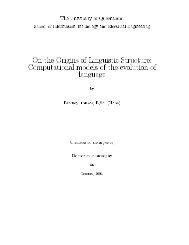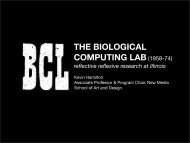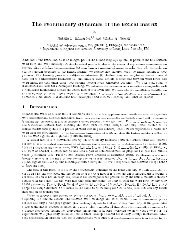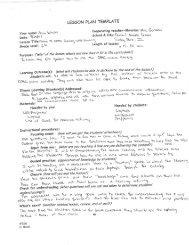Planning and Managing an Exhibition Programme
Planning and Managing an Exhibition Programme
Planning and Managing an Exhibition Programme
Create successful ePaper yourself
Turn your PDF publications into a flip-book with our unique Google optimized e-Paper software.
dawn of<br />
he world.<br />
>m Salem<br />
immense<br />
rgl<strong><strong>an</strong>d</strong> <strong>an</strong><br />
leveloped<br />
wing <strong><strong>an</strong>d</strong><br />
rblished a<br />
'resenting<br />
, including<br />
culture in<br />
tions that<br />
cf art <strong><strong>an</strong>d</strong><br />
ridge <strong><strong>an</strong>d</strong><br />
useum is<br />
r <strong><strong>an</strong>d</strong> that<br />
Iture. The<br />
uminating<br />
,id ch<strong>an</strong>ge<br />
rdent,one<br />
cential for<br />
s heritage<br />
axp<strong><strong>an</strong>d</strong>ing<br />
vrney Into<br />
; a vehicle<br />
rudiences.<br />
'tistic <strong><strong>an</strong>d</strong><br />
r a variety<br />
travellers<br />
' traveller.<br />
on <strong><strong>an</strong>d</strong> is<br />
'... I am part of all that I have meq<br />
Yet all experience is <strong>an</strong> arch wherethro'<br />
Gleams that untravell'd world whose margin fades<br />
For ever <strong><strong>an</strong>d</strong> ever when I move'<br />
Ulysses<br />
Alfred, Lord Tennyson<br />
Odyssey was developed to simulate the experience of journeying within a familiar museum<br />
environment. The exhibition within the galleries was designed to present unfamiliar<br />
encounters. In this way the visitor moving within the gallery environment traversed unknown<br />
territory much as a traveller would. On their own, in troups, or sometimes led by guides,<br />
visitors could begin making connections with art that sp<strong>an</strong>s the globe <strong><strong>an</strong>d</strong> cuts across cultural<br />
boundaries, uniting people with art, ideas <strong><strong>an</strong>d</strong> each other. The exhibit sought to elicit intrigue<br />
with the unfamiliar; the joy of discovery <strong><strong>an</strong>d</strong> the excitement of thinking in new ways.<br />
The exhibition was org<strong>an</strong>ised into five distinct but interconnected galleries, a total of over<br />
14,000 ft2 (1,300 m2).All Odyssey galleries were completely renovated for the exhibition with<br />
new finishes, lighting,fire protection <strong><strong>an</strong>d</strong> climate control.The renovations were part of the<br />
museum's major overall exp<strong>an</strong>sion,to be completed in 2O03.Visitors to Odyssey passed from<br />
one gallery to <strong>an</strong>other in specific sequence, although within a single gallery each could choose<br />
his or her own path <strong><strong>an</strong>d</strong> pace.<br />
Odyssey,a large <strong><strong>an</strong>d</strong> long exhibition, did indeed cover signific<strong>an</strong>t territory: nearly 400 art objects<br />
from every continent. Although the exhibition could be enjoyed superficially in about a onehour<br />
visit, the extent to which a casual uninformed visitor could explore the galleries was<br />
limited.The exhibition was primarily developed to attract repeat visitors from new audiences<br />
comprised of museum-goers <strong><strong>an</strong>d</strong> world art connoisseurs from Boston's North Shore <strong><strong>an</strong>d</strong> the<br />
Boston metropolit<strong>an</strong> area. These groups are increasingly aftracted to the Peabody Essex<br />
Museum as it pursues its new approach to exhibitions <strong><strong>an</strong>d</strong> programming. Odyssey was designed<br />
to be visited m<strong>an</strong>y times <strong><strong>an</strong>d</strong> to be a basis for exp<strong><strong>an</strong>d</strong>ing audiences <strong><strong>an</strong>d</strong> attracting new<br />
memberships.<br />
Odyssey was scheduled for a lengthy run of at least one y"".. thit was partly to accommodate<br />
repeat visitation, but also because Odyssey was pl<strong>an</strong>ned to be the centrepiece venue for a full<br />
schedule of maior events <strong><strong>an</strong>d</strong> development programming in conjunction with <strong><strong>an</strong>d</strong> celebrating<br />
the museum's bicentennial year. In addition, Odyssey provided the opportunity to completely<br />
reorg<strong>an</strong>ise <strong><strong>an</strong>d</strong> revamp overall educational programming to embrace better the museumt<br />
new more dynamic, interdisciplinary approach to interpreting its collections. The general<br />
museum tour, docent curricula <strong><strong>an</strong>d</strong> school programming were strongly reoriented towards<br />
Odyssey's interpretative approach.<br />
Odyssey was conceived as a special bicentennial exhibition of ambitious scope that would<br />
attract new audiences <strong><strong>an</strong>d</strong> engage them on m<strong>an</strong>y different levels. Much more import<strong>an</strong>tly, it<br />
was developed as a product of the museum's new interdisciplinary approach to presenting<br />
art <strong><strong>an</strong>d</strong> culture. Signific<strong>an</strong>t regional <strong><strong>an</strong>d</strong> national marketing efforts to reposition the museum<br />
would be based, in large measure, on the concepts <strong><strong>an</strong>d</strong> interpretative direction of Odyssep ln<br />
order to. bring all possible resources to bear, the museum instituted a new multi-disciplinary<br />
approach to conceptualisation, development <strong><strong>an</strong>d</strong> implementation of the exhibition. This<br />
PLANNING AND MANAGING AN EXHIBITION PROGRAMME 269







